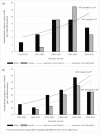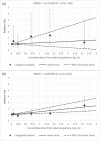Risk of malignant skin neoplasms in a cohort of workers occupationally exposed to ionizing radiation at low dose rates
- PMID: 30289933
- PMCID: PMC6173419
- DOI: 10.1371/journal.pone.0205060
Risk of malignant skin neoplasms in a cohort of workers occupationally exposed to ionizing radiation at low dose rates
Abstract
Recently an increasing trend in skin cancer rates has been observed in various populations including those exposed to different radiation types. Risk and dose-response following prolonged radiation exposure remain unclear. The present study was aimed to assess skin melanoma (SM) and non-melanoma skin cancer (NMSC) incidence risks in a cohort of workers occupationally exposed to ionizing radiation at low dose rates over prolonged periods. The study cohort included workers of a Russian nuclear production facility, Mayak Production Association (PA), who were first employed in 1948-1982 and followed up till the end of 2013 (the total of 22,377 individuals with 25% of females). Using AMFIT module of EPICURE software, relative risk and excess relative risk per unit dose (RR and ERR/Sv) were calculated. 60 SM and 294 NMSC cases were registered in members of the study cohort. SM and NMSC incidence was dependent on sex, attained age, age at first employment at the enterprise, type of facility, education level and was not dependent on calendar period of first employment, calendar period of diagnosis, duration of employment, smoking and alcohol consumption statuses. The risk of NMSC incidence was found to be significantly increased in workers occupationally exposed to ionizing radiation at cumulative doses above 2.0 Sv (RR = 2.52; 95% CI: 1.60, 3.97) compared to a reference dose category (0-0.05 Sv). NMSC incidence was found to be significantly associated with cumulative external gamma-dose with ERR/Sv of 0.49 (95% CI: 0.22, 0.90) without an adjustment for neutron dose and 0.51 (95% CI: 0.22, 0.93) while adjusted for neutron dose. Results of the analysis did not reveal a significant association of SM incidence with cumulative dose from external gamma-rays with ERR/Sv of 0.22 (95% CI: -0.29, 1.46) not including a neutron dose adjustment and of 0.15 (95% CI: -0.41, 1.31) while adjusted for dose from neutron exposure.
Conflict of interest statement
The authors have declared that no competing interests exist.
Figures





Similar articles
-
Risk of skin cancer by histological type in a cohort of workers chronically exposed to ionizing radiation.Radiat Environ Biophys. 2021 Mar;60(1):9-22. doi: 10.1007/s00411-020-00883-6. Epub 2021 Jan 3. Radiat Environ Biophys. 2021. PMID: 33389049
-
Risk of various types of cataracts in a cohort of Mayak workers following chronic occupational exposure to ionizing radiation.Eur J Epidemiol. 2018 Dec;33(12):1193-1204. doi: 10.1007/s10654-018-0450-4. Epub 2018 Oct 10. Eur J Epidemiol. 2018. PMID: 30306422
-
Occupational exposure to chronic ionizing radiation increases risk of Parkinson's disease incidence in Russian Mayak workers.Int J Epidemiol. 2020 Apr 1;49(2):435-447. doi: 10.1093/ije/dyz230. Int J Epidemiol. 2020. PMID: 31722376
-
Melanoma and ionizing radiation: is there a causal relationship?Radiat Res. 2005 Nov;164(5):701-10. doi: 10.1667/rr3447.1. Radiat Res. 2005. PMID: 16238450 Review.
-
Radiation in the workplace-a review of studies of the risks of occupational exposure to ionising radiation.J Radiol Prot. 2009 Jun;29(2A):A61-79. doi: 10.1088/0952-4746/29/2A/S05. Epub 2009 May 19. J Radiol Prot. 2009. PMID: 19454806 Review.
Cited by
-
Occupational Risk Factors for Skin Cancer: A Comprehensive Review.J Korean Med Sci. 2024 Nov 4;39(42):e316. doi: 10.3346/jkms.2024.39.e316. J Korean Med Sci. 2024. PMID: 39497567 Free PMC article. Review.
-
Radiation Safety and Hormesis.Front Public Health. 2020 Jul 24;8:278. doi: 10.3389/fpubh.2020.00278. eCollection 2020. Front Public Health. 2020. PMID: 32793535 Free PMC article. No abstract available.
-
Nonmelanoma Skin Cancers: Embryologically Relevant Sites and UV Exposure.Plast Reconstr Surg Glob Open. 2020 Apr 7;8(4):e2683. doi: 10.1097/GOX.0000000000002683. eCollection 2020 Apr. Plast Reconstr Surg Glob Open. 2020. PMID: 32440398 Free PMC article.
-
Low-dose ionizing radiation and the exposure-lag response: protocol for a prospective cohort study on The Health Effects of Chongqing Occupational Radiation Workers.Front Public Health. 2025 Jan 27;13:1531546. doi: 10.3389/fpubh.2025.1531546. eCollection 2025. Front Public Health. 2025. PMID: 39931302 Free PMC article.
References
-
- Ferlay J, Shin HR, Bray F, Forman D, Mathers C, Parkin DM (2010) GLOBOCAN 2008 v1.2 cancer incidence and mortality worldwide: IARC CancerBase No. 10 (Internet). Lyon, France: International Agency for Research on Cancer; available from http://globocan.iarc.fr
-
- Dermatooncologiya (malignant skin neoplasms, primary skin lymphomas) Atlas: eds Kungurova NV. Ekaterinburg: MaksInfo; 2016. [in Russian]
-
- Risk of solid cancers following radiation exposure: Estimates for the UK population. Report of the Independent Advisory Group on Ionising Radiation Doc HPA, RCE-19, 2011 1–258 (www.gov.uk/government/publications/radiation-risk-of-solid-cancers-follo...).
-
- Rastrelli M, Tropea S, Rossi CRand Alaibac M: Melanoma: epidemiology, risk factors, pathogenesis, diagnosis and classification. In Vivo. 2014;28:1005–1011. - PubMed
MeSH terms
LinkOut - more resources
Full Text Sources
Medical

